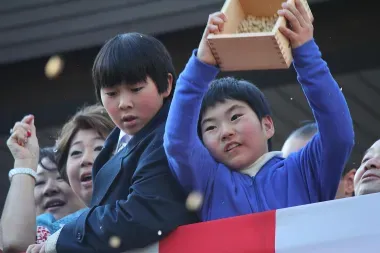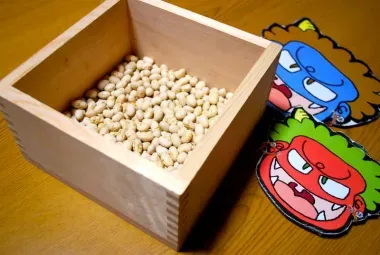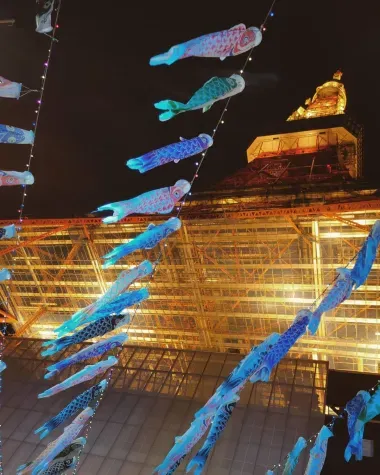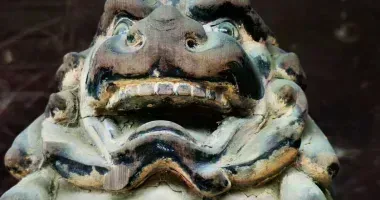Children's Festivals in Japan
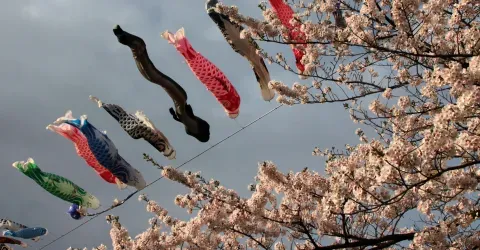
The eel with its fellow carp swimming in the sky
Jerome Laborde
The Best Children's Matsuri in Japan
Children hold a very special place in Japanese society. It is therefore natural that several festivals were dedicated to them throughout the year. Whether national, local, or simple traditions not listed in the calendar, the following events all put children at the heart of celebration. Religious customs for the most part, which aim to make the future of the nation grow in the best conditions.
Seijin no Hi, the day of access to the majority (the 2nd Monday of January)
Established as a holiday since 1948, Seijin no Hi has been an important day for all young adults in Japan. And for good reason, it is the day of seijin shiki, or Coming of Age Day!
Inherited from a 7th century Shinto ceremony in which boys from 10 to 15 years old and girls from 12 to 16 years old participate, seijin shiki is borrowed from this tradition. When the boys used to choose their adult name and the young girls put on their first female clothes, the present ceremony is a little less formal.
Young people who have turned 20 in the year are called to go to the town hall of their neighborhood to receive an official speech on the importance of entering adulthood, and the participants then visit their local shrine accompanied by their families to the delight of passers-by.
Seijin no Hi is a treat for all who love beautiful Japanese fabrics! Furisode (long-sleeved kimono) that is worn by young unmarried women and the formal hakama is worn by the young men, young adults wear their best outfits when it comes to visiting the shrine for the first time (officially) being an adult. There, they will generally ask for professional success and luck in love with the deities, as a pledge of good fortune for the years to come.
- Read also: Wafuku, traditional clothes and accessories
Setsubun, the bean throwing festival (3rd February)
A popular festival, Setsubun aims to celebrate the arrival of spring. If it does not actually pay homage to the children, the party nevertheless puts them in the spotlight since they are the main participants in the most important rite of the festivities: mame maki, the bean throwing.
Used to ward off evil spirits, mame maki is one of the most fun Shinto rituals for Japanese children. Handfuls of beans are thrown at a demon, a man wearing an Oni mask, which symbolizes the evil spirits.
The demon will then give way to spring and its benefits as a reward for their effort, for their greatest pleasure as that of their parents.
Very popular in Japan, the traditions of Setsubun give rise to numerous festivities each year. They are accompanied for example by a Lantern Festival in Kyoto and Nara, and several giant mame maki are organized in the large shrines of cities around the country. It was also at this time that the goodies such as candy or costumes with images of Japanese demons appear in stores, however, wear at your own risk!
- Read also: Japanese monsters and ghosts
Hina Matsuri, the doll festival (3rd March)
Also called Momo Matsuri or ''peach feast'', Hina Matsuri puts little girls in the spotlight every year.
Literally "doll festival'', is inherited from the Heian era (794-1192), at the time when the nobles offered court figurines to the imperial couple to protect them from evil spirits.
If today it is customary to offer the little girls of the household similar figurines, tradition has kept its share of esotericism. And the dolls are now on display in the living room for a short week, in order to keep the young ladies away from bad luck in love. However, they will have to be removed quickly once the celebrations are over, if not, the girl may never marry!

Dolls from Hina Matsuri
Flick/coniferconifer
To celebrate Hina Matsuri, there are several events are organized outside the family circle.
The party is no longer just for families with a little girl, but all Japanese can now enjoy it. This is why you can admire the dolls of the peach festival in certain public spaces, like the Hotel Gajoen in Tokyo, which amazes every year a hundred visitors with its Hyakudan Hinamatsuri, or the Shimogamo shrine in Kyoto, which organizes a festival where the dolls take off on the surrounding rivers.
Many of the sweet treats for the celebration are tinted pink to honor the girls as well as the foodies.
Hamamatsu Matsuri, the kite festival (3rd - 5th May)
The Hamamatsu kite festival has a nice meaning since it celebrates the little boys of the region born during the year.
This local tradition actually dates from the sixteenth century to the time when they celebrated the birth of a male heir by launching several kites in the skies. If the custom spread thereafter on the archipelago to come to decorate the famous "children's party'' on 5th of May, it also remained in Hamamatsu which made it a local festival of several days around the same date.
Since then, it is customary to have 100 kites fight over the sand dunes on which the names of the babies of the year are written. The winner will be the one who succeeds in cutting the strings of all enemy kites, with wind and technique as their only weapons.

Hamamatsu festival
Wikimédia
Kodomo no Hi, children's day (5th May)
Designated as the "children's party", this holiday actually celebrates little boys.
The tradition began in China when the iris flowers were celebrated in May, before transforming in contact with the Japanese nobility under Kamakura (1185-1333), where it became customary in the samurai families to offer part of their armor to little boys.
We also find this element today, since we still exhibit replicas of kabuto (samurai helmets) in the entrances of houses sheltering a small man - the latter being supposed to bring good luck and good health to the male heirs of the family.
Kodomo no Hi being one of the most popular festivals in the country, Japan is also adorned with carp streamers ( or koi no bori ) for the occasion. These are all inherited right to the tradition of kites of Hamamatsu, and thus find themselves floating in the wind the window sills of the houses or public places to wish good health to all children. This is why, several events around the koi no bori are organized all over the country in May, starting with Tokyo, where Tokyo Tower and Roppongi Hills hold each year a festival of banners.
Shichi-Go-San, the day of 3, 5 and 7 years old (15th November)
Literally "seven, five, three", Shichi-Go-San is dedicated to children aged three, five and seven.
The tradition goes back to antiquity when the nobility used to celebrate children aged three, five and seven years old.
Indeed, these ages were important at the time when infant mortality was high since they structured childhood and marked rites of passage: the hair of children at three years of age was cut for the first time; the boys began to wear the hakama at five, and a child was considered to be truly part of the family at seven years of age - the chances of survival being slim before that age.
Fortunately today, things have changed! That said, the tradition has continued, and the little Japanese of these ages are still in the habit of visiting the local shrine on November 15 for good luck and good health for the rest of their childhood. Dressed in kimono for girls and hakama for boys , it is therefore with happiness and kindness that we can see them being photographed by their parents and grandparents near places of worship at the end of the year.
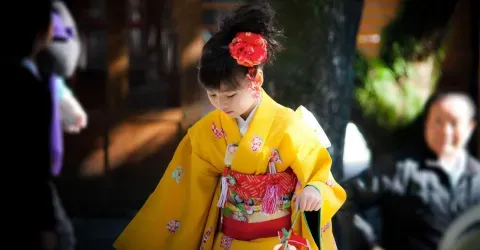
Shichi Go San
10wallpaper.com

